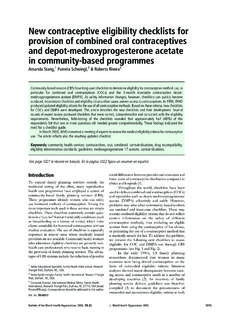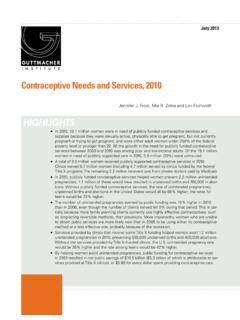Transcription of Contraceptive prevalence rate (%) - WHO | World …
1 38 Contraceptive prevalence rate (%) Rationale for use Contraceptive prevalence rate is an indicator of health, population, development and women's empowerment. It also serves as a proxy measure of access to reproductive health services that are essential for meeting many of the Millennium Development Goals (MDG)s, especially the child mortality, maternal health HIV/AIDS, and gender related goals. Definition Contraceptive prevalence rate is the proportion of women of reproductive age who are using (or whose partner is using) a Contraceptive method at a given point in time Associated terms Contraceptive methods include clinic and supply (modern) methods and non-supply (traditional) methods. Clinic and supply methods include female and male sterilization, intrauterine devices (IUDs), hormonal methods (oral pills, injectables, and hormone-releasing implants, skin patches and vaginal rings), condoms and vaginal barrier methods (diaphragm, cervical cap and spermicidal foams, jellies, creams and sponges).
2 Traditional methods include rhythm, withdrawal, abstinence and lactational amenorrhoea. Data sources Household surveys [such as Demographic and Health Surveys (DHS), Multiple Indicators Cluster Surveys (MICS)], Contraceptive prevalence surveys. Estimates can also be made from service statistics using census projections as a denominator. Such estimates however are often expressed in terms of couple years of protection and may not always be complete. Methods of estimation Empirical data only. Disaggregation By age (adolescence), marital status, method of contraception, location (urban/rural, major regions/provinces), and socio-economic characteristics ( education level, wealth quintile) References - Levels and Trends of Contraceptive Use. Sales No. New York, United Nations, 2001: ( ) - World Contraceptive Use 2001. Wall Chart. Sales No. New York, United Nations, 2002. ( ) - The World Health Report 2005: Make every mother and child count. Annex Table 8. Geneva, World Health Organization, 2005.
3 ( ) - Reproductive Health Indicators: Guidelines for their generation, interpretation and analysis for global monitoring. (in press). Geneva, World Health Organization, 2006. Database 39 - UN Population Division: ( ) - Demographic and Health Survey (DHS): ( ) - UNICEF: statistics and Multiple Indicator Cluster Survey: ( ) Comments Measures of Contraceptive prevalence are usually derived from interviews with representative samples of women of reproductive age. In many surveys, questions on current Contraceptive use are confined to married women, including those in consensual unions where such unions are
















